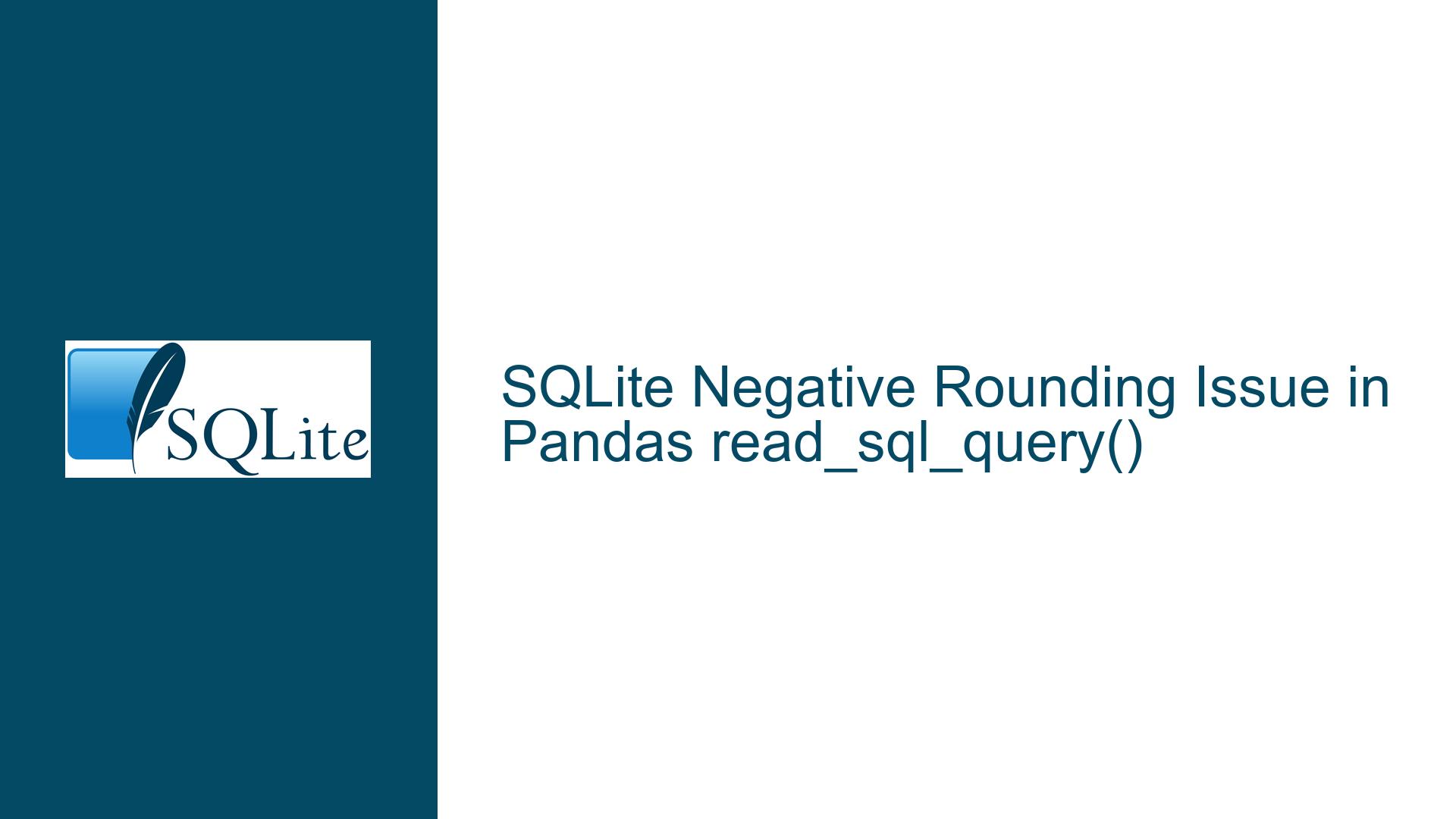SQLite Negative Rounding Issue in Pandas read_sql_query()
Understanding the Negative Rounding Behavior in SQLite
The core issue revolves around the behavior of the round() function in SQLite when used with negative rounding parameters, particularly when invoked through Pandas’ read_sql_query() function. Negative rounding, a technique often used for binning or bucketing data, is expected to round numbers to the left of the decimal point. For example, rounding 12425.22 to the nearest thousand (using round(score, -3)) should yield 12000. However, in SQLite, this behavior does not work as expected, and the function instead rounds to the nearest integer, ignoring the negative rounding parameter.
This discrepancy arises due to SQLite’s implementation of the round() function, which treats negative rounding parameters as 0, effectively rounding to the nearest integer. This behavior is documented but can be counterintuitive for users expecting functionality similar to other database systems or programming languages. The issue becomes particularly noticeable when using Pandas’ read_sql_query() to execute SQL queries against an SQLite database, as the results do not align with the expected binning or bucketing outcomes.
Why SQLite’s round() Function Behaves Differently
The behavior of SQLite’s round() function is rooted in its design and historical implementation. Unlike some other database systems, SQLite’s round() function does not support negative rounding parameters to round numbers to the left of the decimal point. Instead, it treats negative values as 0, resulting in rounding to the nearest integer. This behavior is explicitly documented in the SQLite documentation, which states: "If the Y argument is omitted or negative, it is taken to be 0."
This design choice is likely due to the simplicity and performance considerations of SQLite, which prioritizes lightweight and efficient operations. Implementing negative rounding would require additional logic and computational overhead, which may not align with SQLite’s goals as a minimalistic database engine. Additionally, the lack of hardware or runtime support for advanced rounding techniques in certain C language standards further complicates the implementation of more sophisticated rounding behavior.
Another factor contributing to this behavior is the distinction between "kindergarten rounding" and "proper rounding." SQLite’s round() function uses a basic rounding method (often referred to as "kindergarten rounding"), which rounds numbers to the nearest integer without considering advanced rounding rules like "round to nearest ties to even." Implementing more advanced rounding techniques, including negative rounding, would require significant changes to the underlying code and could introduce compatibility issues with existing applications.
Resolving the Negative Rounding Issue in SQLite and Pandas
To address the negative rounding issue in SQLite and achieve the desired binning or bucketing behavior, users can employ alternative approaches. These solutions range from modifying the SQL query to using custom functions or leveraging Pandas’ capabilities for post-processing the data.
Custom SQLite Rounding Function
One effective solution is to create a custom rounding function in SQLite that supports negative rounding parameters. This can be achieved by extending SQLite’s functionality using its C API or by defining a user-defined function (UDF) in Python. Below is an example of a custom rounding function implemented in Python using SQLite’s create_function() method:
import sqlite3
import math
def custom_round(value, digits):
if value is None:
return None
scale = 10 ** digits
return math.floor(value * scale + 0.5) / scale
conn = sqlite3.connect(":memory:")
conn.create_function("custom_round", 2, custom_round)
cursor = conn.cursor()
cursor.execute("CREATE TABLE test (score REAL)")
cursor.execute("INSERT INTO test VALUES (12425.22), (200.002), (310.2656)")
cursor.execute("SELECT score, custom_round(score, -3) AS rounded FROM test")
results = cursor.fetchall()
print(results)
This custom function, custom_round(), mimics the behavior of negative rounding by scaling the input value, rounding it to the nearest integer, and then scaling it back. When used in an SQL query, it produces the expected results, such as rounding 12425.22 to 12000.
Modifying the SQL Query
Another approach is to modify the SQL query to achieve the desired rounding behavior without relying on SQLite’s round() function. This can be done by using mathematical operations to simulate negative rounding. For example:
SELECT
score,
round(score / 1000) * 1000 AS rounded
FROM
test;
In this query, the score is divided by 1000, rounded to the nearest integer, and then multiplied by 1000 to achieve the effect of rounding to the nearest thousand. This method avoids the limitations of SQLite’s round() function and produces the correct results.
Post-Processing in Pandas
If modifying the SQL query or extending SQLite’s functionality is not feasible, the rounding operation can be performed in Pandas after retrieving the data. This approach leverages Pandas’ robust data manipulation capabilities to achieve the desired binning or bucketing:
import pandas as pd
import sqlite3
conn = sqlite3.connect("stack.db")
df = pd.read_sql_query("SELECT * FROM stack", conn)
def custom_round(value, digits):
scale = 10 ** digits
return (value // scale) * scale
df['negative_round'] = df['score'].apply(lambda x: custom_round(x, -3))
print(df)
In this example, the custom_round() function is applied to the score column in the Pandas DataFrame, rounding each value to the nearest thousand. This approach provides flexibility and avoids the limitations of SQLite’s round() function.
Using External Libraries
For users who require advanced rounding capabilities, external libraries such as NumPy or SciPy can be used to perform the rounding operation. These libraries offer a wide range of mathematical functions, including support for negative rounding:
import pandas as pd
import sqlite3
import numpy as np
conn = sqlite3.connect("stack.db")
df = pd.read_sql_query("SELECT * FROM stack", conn)
df['negative_round'] = np.round(df['score'], -3)
print(df)
In this example, NumPy’s round() function is used to round the score column to the nearest thousand. This approach is straightforward and leverages the capabilities of a well-established numerical computing library.
Conclusion
The negative rounding issue in SQLite arises from the design and implementation of its round() function, which does not support negative rounding parameters. While this behavior is documented, it can be counterintuitive for users expecting functionality similar to other database systems or programming languages. By understanding the underlying causes and exploring alternative solutions, such as custom rounding functions, modified SQL queries, post-processing in Pandas, or external libraries, users can achieve the desired binning or bucketing behavior. These approaches provide flexibility and ensure that data manipulation tasks can be performed effectively, even within the constraints of SQLite’s lightweight design.






